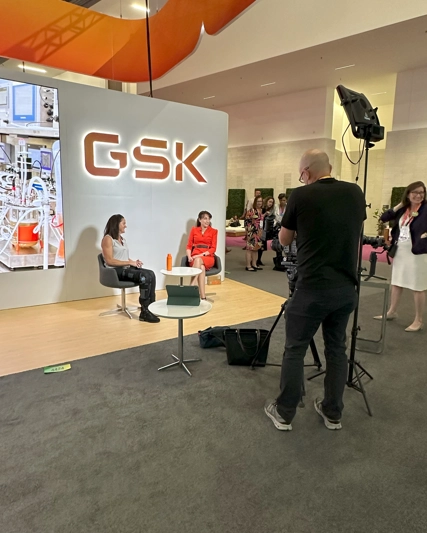Two positive phase III studies of tafenoquine for the radical cure of Plasmodium vivax malaria published in The New England Journal of Medicine
GSK and Medicines for Malaria Venture (MMV) today announced the publication of positive results from two phase III studies of single-dose tafenoquine for the radical cure (prevention of relapse) of Plasmodium vivax (P. vivax) malaria in The New England Journal of Medicine.
Issued: London UK; Philadelphia US; Geneva Switzerland
Headline results from the DETECTIVE and GATHER studies, part of a comprehensive global P. vivax radical cure clinical development programme, were announced in June 2017. The results supported the approval of single-dose (1-day) tafenoquine by the U.S. Food and Drug Administration (FDA) in July 2018 (Krintafel) and the Australian Therapeutic Goods Administration (TGA) in September 2018 (Kozenis) for the radical cure of P. vivax malaria, a disease that is estimated to cause around 7.5 million clinical infections every year. The existing standard of care, primaquine, must be taken for 14 days making compliance often low in endemic settings.
The DETECTIVE study, conducted in 522 patients investigated a 1-day course of tafenoquine (300mg), a 14-day course of primaquine (15mg), or placebo, with all patients also receiving a 3-day course of chloroquine to treat clinical symptoms, met its primary endpoint.1
- Using a confirmed FDA-preferred analysis (Kaplan Meier analysis), a significantly greater proportion of patients in the tafenoquine group remained relapse-free over the 6-month follow-up period compared with patients in the placebo group (62.4% vs 27.7%), with an odds ratio of 0.3, p<0.001. Further, a significantly greater proportion of patients in the primaquine group were relapse-free over the 6-month follow-up period compared with patients on placebo (69.6% vs 27.7%), with an odds ratio of 0.26, p<0.001. High compliance with primaquine treatment of greater than 95% was observed in this controlled clinical setting.
- Adverse events from the study were consistent with the known safety profile of tafenoquine. Mild, asymptomatic declines in haemoglobin (a protein in red blood cells that carries oxygen) were observed more frequently in patients taking tafenoquine, and all recovered without intervention. The proportion of patients experiencing adverse events (AEs) in the first 29-days during the 6-month study was similar for each treatment group; the frequency was 48.8% for tafenoquine, 46.5% for primaquine, and 48.9% for placebo. The frequency of serious AEs was 8.1% for tafenoquine (n=21, 14 of which were due to decline in haemoglobin that were all mild to moderate in severity and all recovered without specific medical intervention), 3.1% (n=4) for primaquine and, 4.5% (n=6) for placebo.
The GATHER study, conducted in 251 patients, investigated the effect of a single-dose of tafenoquine (300mg) on levels of haemoglobin when compared to a 14-day course of primaquine (15mg), with all patients also receiving a standard 3-day course of chloroquine.2
- The incidence of decline in haemoglobin (the primary endpoint) was very low and similar between the two treatment groups (2.4% for patients receiving tafenoquine 1.2% for patients receiving primaquine), with the difference in proportions (95% CI) of 1.23% (-4.16%, 4.98%).
- The frequency of adverse events was 72% for the tafenoquine group and 75% for the primaquine group and the frequency of serious adverse events was 4% for the tafenoquine group and 1% for the primaquine group.
The regulatory approvals of tafenoquine by the FDA and TGA will be informative to regulatory agencies in malaria-endemic countries.Tafenoquine will be provided at an affordable price to maximise access of the medicine to those who need it most.
Dr. Hal Barron, Chief Scientific Officer and President of Research and Development, GSK, said: “Treating Plasmodium vivax malaria is particularly challenging because the parasite has the ability to lie dormant in the liver resulting in relapses. Poor compliance to primaquine treatment in real-world settings can lead to higher relapse rates than those seen in the controlled setting of clinical trials, so a single-dose treatment with tafenoquine is an attractive proposition. We are pleased to have the results of these pivotal studies published today, and look forward to progressing further regulatory filings of tafenoquine in P.vixax endemic countries.”
Dr. David Reddy, Chief Executive Officer of MMV said: “Without treatment to stop the relapse of P. vivax, infected patients live with the constant threat of malarial symptoms returning without warning. MMV and GSK, long-standing partners in the fight against malaria, developed tafenoquine to help put a stop to the relapse. We are delighted to see the results of the phase III studies published in the NEJM. These positive results demonstrate the efficacy and safety of tafenoquine in an unprecedented single-dose for relapsing malaria, potentially offering countries a new tool as they strive towards malaria elimination.”
About DETECTIVE (TAF112582) study
The Dose and Efficacy Trial Evaluating Chloroquine and Tafenoquine In Vivax Elimination (DETECTIVE) study was a double-blind, double-dummy phase III study evaluating the efficacy, safety and tolerability of tafenoquine in 522 patients with P.vivax malaria from Ethiopia, Peru, Brazil, Cambodia, Thailand, and the Philippines. Patients were randomised to receive either a single-dose (1-day) of tafenoquine (300mg), a 14-day course of primaquine (15mg), or placebo, with all patients also receiving a 3-day course of chloroquine to treat the acute blood stage of the infection.
About GATHER (TAF116564) study
The Global Assessment of Tafenoquine HEmolytic Risk (GATHER) study was a double-blind, double-dummy phase III safety study evaluating the effect of tafenoquine (300mg) on the levels of haemoglobin when compared to a 14-day course of primaquine (15mg), with all patients also receiving a standard 3-day course of chloroquine. The study was conducted in 251 patients with
P. vivax malaria from Peru, Brazil, Columbia, Vietnam, and Thailand.
About tafenoquine (brand names: Krintafel in the US / Kozenis in Australia)
Kozenis/Krintafel is an 8-aminoquinoline derivative with activity against all stages of the P. vivax lifecycle, including hypnozoites. It was first synthesised by scientists at the Walter Reed Army Institute of Research in 1978. GSK’s legacy in the research and development of tafenoquine as a potential medicine for malaria commenced over 20 years ago. In 2008, GSK entered into a collaboration with the not-for-profit product development partnership, MMV, to develop tafenoquine as an anti-relapse medicine for patients infected with P. vivax. The tafenoquine clinical programme is part of GSK’s global health programme aimed at improving healthcare for vulnerable populations.
About Plasmodium vivax malaria
P. vivax malaria has a significant public health and economic impact, primarily in South-Asia, South-East Asia, Latin America and the horn of Africa. The disease is estimated to cause around 7.5 million clinical infections every year.3 The clinical features of P. vivax malaria include fever, chills, vomiting, malaise, headache and muscle pain, and in some cases, can lead to severe malaria and be fatal.4
The Plasmodium parasite is a complex organism with a lifecycle spanning both humans and mosquitoes.5 After an infected mosquito bite, the P. vivax parasite infects the blood and causes an acute malaria episode. It also has the ability to lie dormant in the liver (in a form known as hypnozoite) from where it periodically reactivates to cause relapses of P. vivax malaria. Hence, a single P. vivax infection can give rise to multiple episodes of malaria, in the absence of a new mosquito bite. These relapses can occur weeks, months or even years after the initial infection. The dormant liver forms of the parasite cannot be treated with most antimalarial treatments active against the blood-stage parasite.
The use of a medicine that targets the dormant liver forms of the P. vivax parasite, co-administered with currently available antimalarials such as chloroquine or artemisinin-based combination therapies (ACTs) is known as radical cure. Up to recently, the 8-aminoquinoline, primaquine, was the only approved medicine to target the dormant liver stage to prevent relapse.6 However, primaquine’s 14-day treatment regimen is often associated with poor compliance, resulting in reduced effectiveness.7, 8, 9
GSK’s commitment to malaria
Malaria remains one of the greatest global healthcare challenges. Whilst good progress has been made in the fight against malaria this progress is fragile. GSK supports the WHO target to cut malaria cases and deaths by 90% by 2030 and believes that with renewed global commitment from all stakeholders working together, this goal can be met. GSK is playing its part by building on its 40-year commitment to work with partners to fight malaria in the lab and on the ground.
Important safety information
CONTRAINDICATIONS
Tafenoquine is contraindicated in the following:
- G6PD deficiency
- Pregnancy
- Breastfeeding an infant who is G6PD deficient or if the G6PD status of the infant is unknown
- Patients with known hypersensitivity to tafenoquine, other 8-aminoquinolines, or any component of the formulation
SPECIAL WARNINGS AND PRECAUTIONS FOR USE
Haemolytic anaemia and G6PD deficiency
Due to the risk of haemolytic anaemia in patients with G6PD deficiency, G6PD testing must be performed before prescribing tafenoquine. Withhold tafenoquine from patients with G6PD enzyme levels <70% of normal. Monitor patients for clinical signs or symptoms of haemolytic anaemia. Advise patients to seek medical attention if signs of haemolytic anaemia occur.
Methaemoglobinaemia
Asymptomatic elevations in methaemoglobin were observed in clinical studies (see section 4.8 Adverse effects). If signs or symptoms of methaemoglobinaemia occur, appropriate therapy should be instituted. Caution is advised in patients with nicotinamide adenine dinucleotide (NADH)-dependent methaemoglobin reductase deficiency.
Psychiatric Effects
Mild to moderate, self-limiting psychiatric adverse reactions (e.g. anxiety, abnormal dreams) have been reported in clinical trials of tafenoquine. While there were no reports of serious psychiatric adverse reactions in clinical trials following a single 300 mg dose, cases of depression and psychosis have occurred following higher single doses (350 to 600 mg) of tafenoquine, mostly in subjects with a previous history of psychiatric disorders. Serious psychiatric disorders such as psychosis and depression have been associated with some quinoline anti-malarials. Caution is advised when administering tafenoquine to patients with a current or past history of serious psychiatric disorders. Individual patient risk-benefit should be assessed. Due to the long half-life of tafenoquine (15 days), psychiatric effects and hypersensitivity reactions may be delayed in onset and/or duration.
INTERACTIONS WITH OTHER MEDICINES AND OTHER FORMS OF INTERACTIONS
Tafenoquine is an inhibitor of human transporters organic cation transporter 2 (OCT2) and multidrug and toxin extrusion transporter (MATE) in vitro, potentially resulting in increased exposure to their substrates (e.g., dofetilide). There is a small risk of lactic acidosis due to increased metformin exposure secondary to blockade of these transporters. Therefore, use with caution with metformin. Drugs with a narrow therapeutic index that are substrates of the renal transporters OCT2 and MATE should not be co-administered (e.g. phenformin, buformin, dofetilide, procainamide, and pilsicainide).
ADVERSE EFFECTS (UNDESIRABLE EFFECTS)
Common adverse reactions (occurring in >1% of patients treated with tafenoquine) included blood creatinine increased, dizziness, elevated methaemoglobin, haemoglobin decreased, headache, insomnia, nausea, and vomiting
Reporting suspected adverse reactions after registration of the medicinal product is important. It allows continued monitoring of the benefit-risk balance of the medicinal product. Healthcare professionals are asked to report any suspected adverse reactions at https://www.tga.gov.au/reporting-problems.
Trade marks are owned by or licensed to the GSK group of companies.
GSK – one of the world’s leading research-based pharmaceutical and healthcare companies – is committed to improving the quality of human life by enabling people to do more, feel better and live longer. For further information please visit www.gsk.com.
Medicines for Malaria Venture (MMV) - MMV is a leading product development partnership (PDP) in the field of antimalarial drug research and development. Its mission is to reduce the burden of malaria in disease-endemic countries by discovering, developing and facilitating delivery of new, effective and affordable antimalarial drugs.
Since its foundation in 1999, MMV and partners have built the largest portfolio of antimalarial R&D and access projects ever assembled, have brought forward nine new medicines and have assumed the access stewardship of a further two. An estimated 1.9 million lives have been saved by these MMV co-developed medicines. MMV's success is based on its extensive partnership network of around 150 active partners including from the pharmaceutical industry, academia and endemic-countries.
MMV's vision is a world in which innovative medicines will cure and protect the vulnerable and under-served populations at risk of malaria, and help to ultimately eradicate this terrible disease.
GSK cautionary statement regarding forward-looking statements
GSK cautions investors that any forward-looking statements or projections made by GSK, including those made in this announcement, are subject to risks and uncertainties that may cause actual results to differ materially from those projected. Such factors include, but are not limited to, those described under Item 3.D 'Principal risks and uncertainties' in the company's Annual Report on Form 20-F for 2017.
References
- Lacerda M.V.G et al. Single-dose Tafenoquine for Relapse Prevention in Plasmodium vivax Malaria. N Engl J Med 2019; 380: 215-28. DOI: 10.1056/NEJMoa1710775
- Llanos-Cuentas A et al. Tafenoquine versus Primaquine to Prevent Relapse in Plasmodium vivax Malaria. N Engl J Med 2019; 380: 229-41. DOI: 10.1056/NEJMoa1802537
- World Health Organization. World Malaria Report 2018 (2018): www.who.int/malaria/publications/world-malaria-report-2018/report/en/
- Price RN et al. Vivax malaria: neglected and not benign. Am J Trop Med Hyg 2007; 77:79–87.
- Lima Jr JC, Pratt -Riccio LR. Major Histocompatibility Complex and Malaria: Focus on Plasmodium vivax Infection. Frontiers in Immunology 2016; 7(13): 1 -14
- Wells TNC et al. Targeting the hypnozoite reservoir of Plasmodium vivax: the hidden obstacle to malaria elimination. Trends Parasitol 2010; 26:145-151.
- Takeuchi R et al. Directly-observed therapy (DOT) for the radical 14-day primaquine treatment of malarial on the Thai-Myanmar border. Malar J 2010;9:308
- Abreha A et al. Comparison of artemether-lumefantrine and chloroquine with and without primaquine for the treatment of Plasmodium vivax infection in Ethiopia: A randomized controlled trial. PLoS Med 2017;14:e1002299.
- Douglas NM et al. Unsupervised primaquine for the treatment of Plasmodium vivax malaria relapses in southern Papua: a hospital-based cohort study. PLOS Med 2017;14: e1002379.


